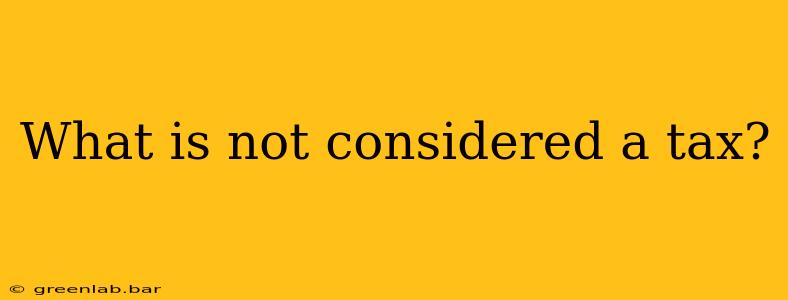The term "tax" gets thrown around a lot, but what actually is a tax, and what isn't? Understanding the difference is crucial for both personal finance and a broader understanding of government function. While the definition can be nuanced, several key characteristics generally define a tax. Let's explore what typically isn't considered a tax, focusing on the key distinctions.
Key Characteristics of Taxes
Before diving into what isn't a tax, it's helpful to understand what makes something a tax. Generally, taxes are:
- Mandatory payments: You're legally obligated to pay them. Failure to do so results in penalties.
- Levied by a government: The funds go towards public services and programs.
- Not directly tied to a specific benefit: While taxes fund services, you don't receive a direct, equivalent service in return for each payment.
- Used for public purpose: Taxes fund infrastructure, education, healthcare, defense, and other government functions.
What is NOT Considered a Tax?
Now, let's examine some common payments that are often confused with taxes, but are distinct:
1. Fees for Specific Services:
These are payments for direct services received. Examples include:
- Court fees: Paying for legal proceedings.
- Permit fees: Obtaining permission for construction or other activities.
- License fees: For driving, professional practices, etc.
- Tolls: Using specific roadways.
Key Difference: These are payments for specific services rendered, not general government funding. You receive a direct benefit in exchange for the fee.
2. Fines and Penalties:
These are punishments for violating laws or regulations. Examples include:
- Traffic tickets: Penalties for breaking traffic laws.
- Late payment penalties: For overdue taxes (ironically!).
- Environmental fines: For polluting or damaging the environment.
Key Difference: While they generate revenue for the government, their primary purpose is punishment, not general funding.
3. User Fees:
These payments provide access to specific government-provided goods or services, often on a cost-recovery basis. Examples include:
- National park entrance fees: Access to national parks.
- Tuition fees for public colleges: Funding for public higher education (though some argue this blurs the lines).
- Water and sewer bills: Providing water and sanitation services.
Key Difference: While resembling taxes, they often aim to cover the cost of providing a specific service, rather than general government funding.
4. Assessments:
These are charges levied to fund specific local improvements that directly benefit the property owner. Examples include:
- Special assessments for street improvements: Funding for road repairs directly benefiting a neighborhood.
- Assessments for sewer line replacements: Covering the cost of replacing aging sewer lines.
Key Difference: They directly benefit the payer and are often tied to a specific improvement project.
The Gray Areas:
Some payments fall into gray areas. For instance, certain government fees might have elements of both a fee and a tax. It’s crucial to understand the specific regulations and the purpose of the payment to determine its true nature. Consulting tax professionals or reviewing relevant legal documents provides clarity in such instances.
Conclusion:
While the line can sometimes blur, understanding the fundamental characteristics of taxes helps distinguish them from other types of payments. Knowing the difference is vital for responsible financial planning and engaging in informed civic discourse about government spending and revenue generation.

